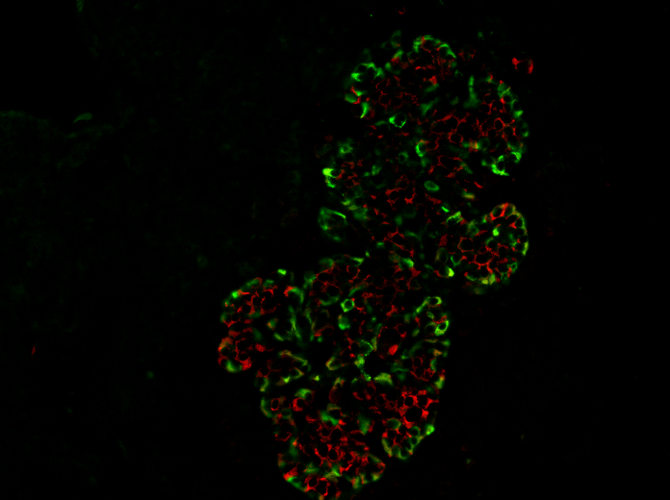First single-cell transcriptomes of pancreas cells established
Share
The pancreas is a crucial organ for eating behavior, digestion and metabolism and it plays a major role in the development of diabetes. In so called “Langerhans Islets”, specialized groups of cells precisely regulate blood sugar. But they are hard to study, only a few molecular markers are known to differentiate those pancreatic cell types. With the first single cell transcriptomes, established by Stefan Kubicek and Christoph Bock at CeMM, a new powerful tool for future investigations has been created to overcome those problems.
Their name is no coincidence: Cells of Langerhans-Islets are distributed throughout the pancreatic tissue in small groups indeed resembling little islands. They consist of highly specialized cells which assume a variety of crucial tasks for the metabolism and digestion of their organism – particularly, the regulation of blood sugar levels by hormones like insulin or glucagon. They also play a major role in diabetes: Damage to insulin-producing beta cells causes the metabolic disease. However, the contribution of other pancreatic cell types is not well understood. Although global change in the gene activity of Langerhans-Islets was observed during the development of diabetes, it was not possible to pin those changes down to the individual cells of the islets. Also, only a few molecular markers are known to distinguish them.
The research groups of Stefan Kubicek and Christoph Bock at CeMM together with colleagues from the Medical University of Vienna and the Geneva University Hospitals now established the first complete maps of genetic activity, so called transcriptomes of single pancreatic cells of Langerhans-Islets. With cutting-edge sequencing technology and library preparation, they were able to discover novel cell type-specific molecular markers and identified human-specific features for the most important members of Langerhans-Islets, insulin-producing beta- and glucagon-reducing alpha cells.
This work provides a powerful tool to investigate the causes and the course of diabetes and will shed light on the molecular mechanisms underlying one of the world´s most widespread diseases with over 1.2 million deaths each year. The complete data of the study is available online for free to foster research on pancreatic islet biology and diabetes-related mechanisms in human.
Publication:
Jin Li, Johanna Klughammer, Matthias Farlik, Thomas Penz, Andreas Spittler, Charlotte Barbieux, Ekaterine Berishvili, Christoph Bock, Stefan Kubicek. Single‐cell transcriptomes reveal characteristic features of human pancreatic islet cell types. EMBO reports (2015), doi 10.15252/embr.201540946.
Funding:
CeMM gratefully acknowledges funding from the Austrian Academy of Sciences, the Juvenile Diabetes Research Foundation, the Austrian Federal Ministry for Science, Research and Economy, the National Foundation for Research, Technology, and Development, and the European Commission.

